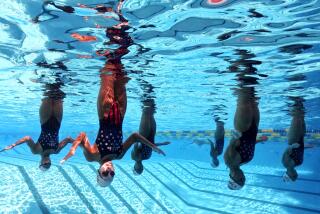Today, People of All Ages, Abilities Enjoy Benefits of Water Fitness
- Share via
It started with thoroughbreds. For decades, trainers have exercised racehorses in ponds and pools to give the animals a workout without the joint-jarring impact of land-based activity.
In recent years, sports medicine experts have embraced aquatic exercise as an ideal way for injured athletes to maintain cardiovascular fitness while rebuilding strength and flexibility in a low-stress environment. High-profile athletes who have taken the plunge to rehabilitate injuries are figure skater Nancy Kerrigan, quarterback Troy Aikman and track star Carl Lewis.
Aquatic exercise is one of the fastest-growing segments of the fitness industry, and a new wave of “vertical” water workouts is sharing pool space with traditional “horizontal” swimming programs.
“More people are recognizing the benefits of exercising in water,” says Julie See, president of the Aquatic Exercise Assn., a Nokomis, Fla.-based organization that has 18,000 certified aquatics fitness professionals, compared with just 1,000 in 1992.
“Ten years ago, water exercise was pretty much for older adults,” See says. “Now you’ll find people of all ages and ability levels doing all kinds of workouts in the pool.” Among the most popular, she says, are classes such as aquatic kick boxing and aquatic boot camp, deep-water running wearing a flotation belt, water walking and practicing Eastern arts such as tai chi and yoga in the pool.
Although water workouts typically are easier on the body than land-based exercise, aquatic activity can be as strenuous as you want to make it, says Pat Cook, aquatic program supervisor for the Fairfax County (Va.) Park Authority.
“Water itself is like a piece of exercise equipment, because it provides about 12 times the resistance of air,” Cook says. Just as your muscles get stronger from working against the resistance of an iron dumbbell, working against the resistance of water also has a strengthening effect.
Water workouts offer a built-in symmetry, Cook says, because every forward pull has a backward pull.
“This means you naturally get a balanced workout in the water,” she says. For those who want an extra strengthening effect, Cook recommends adding resistance with some of the innovative new “pool toys” designed for water workouts, such as webbed gloves and aquatic dumbbells.
“Plus, there’s a tremendous comfort zone in the water,” Cook says. “In a land-based aerobics class, there’s a lot of pressure to keep up, but you can hide in the water and just do as much as you’re able to without anyone knowing.”
Water’s buoyancy counters gravity’s downward pull, “which takes the weight and strain off your joints,” says William Bullough, aquatics director for the Montgomery County (Md.) Recreation Department. “This makes water exercise low- or no-impact, depending on how deep you go. People also like it because you can get a great workout without even knowing how to swim or getting your hair wet.”
In summer’s heat, “you can get a super workout without breaking a sweat,” says Rick North, senior director of adult programs, fitness and aquatics at the Silver Spring (Md.) Branch YMCA. Water also helps assist with balance and removes the fear of falling, he says, making the pool an excellent exercise environment for people who are overweight, pregnant or elderly, as well as those who have ailments such as arthritis or multiple sclerosis.
One of the simplest, fastest-growing forms of aquatic exercise is water walking, says John Spannuth, president of the United States Water Fitness Assn. in Boynton Beach, Fla.
“You can water walk in the shallow end of any pool,” he says. “Many large pools rope off lanes for water walkers, and some even offer water walking as a class.”
Water walking is as easy as putting one foot in front of the other, say aquatics experts, who offer this advice:
* Consider wearing shoes made for water walking or use an old pair of sneakers to protect your feet from the bottom of the pool.
* Warm up by moving around in the water slowly and stretching gently for about five minutes.
* Pick a depth that is challenging yet enjoyable. Chest-deep water is recommended, but if this is too difficult, walk in hip- or waist-deep water.
* Don’t lean forward. When walking in water, your ear, shoulder and hip should be in a straight line.
* Vary how you walk. For example, walk forward, backward and sideways, or march with knees high.
* Move your arms through the water for added intensity.
* Avoid the tendency to stay on your tiptoes, and be sure to walk all the way through your foot. When walking forward, step heel to toe. When walking backward, step toe to heel.
* Increase the intensity by making bigger or faster movements or by adding resistance, such as by cupping your hands instead of keeping them open or in a fist.
* Recognize that water’s cooling effect may result in heart rates that are about 10 to 15 beats lower when you are exercising in water compared with the same effort on land.
* Cool down with stretching and easy movements in the water for about five minutes.
* Have fun. Use your creativity to make your water walking laps different, challenging and enjoyable.
(BEGIN TEXT OF INFOBOX / INFOGRAPHIC)
Water Exercise Resources
More information about water exercise is available from:
* The Aquatic Exercise Assn. Write this group at P.O. Box 1609, Nokomis, FL 34272, call (941) 486-8600, or visit https://aeawave.com.
* The U.S. Water Fitness Assn. will provide water walking information to people who send a self-addressed envelope, stamped with 55 cents postage, to Water Walking, USWFA, P.O. Box 3279, Boynton Beach, FL 33424.
* “Water Exercise,” by Martha White, “Water Fitness After 40,” by Ruth Sova and “Fantastic Water Workouts,” by MaryBeth Pappas Gaines, all published by Human Kinetics. They can be ordered by calling (800) 747-4457.


